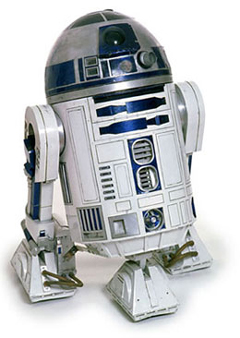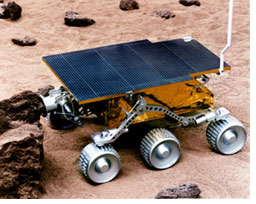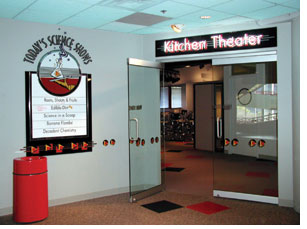

By R.J. Gangewere
What is the Robot Hall of Fame? It was conceived by
Carnegie Mellon’s James Morris, dean of Computer
Science, who assembled a panel of 13 world-wide experts
to choose the most significant robots, real and fictional,
that have impacted the lives of human beings. After
25 years of leadership in robotics science, Carnegie
Mellon wanted to showcase Pittsburgh as the place where
robots are really understood. The university then turned
to Carnegie Science Center as its public partner in
this enterprise. Ellsworth Brown, president of Carnegie
Museums of Pittsburgh, was on the panel that selected
the first four robots for induction into the Hall.
At Carnegie Science Center the display for the Robot
Hall of Fame is located at the entrance to Robotics,
the Science Center exhibition that demonstrates how
robotic technology has changed modern life. This entertaining,
hands-on exhibit can be seen through September 6, 2004.
To share the Robot Hall of Fame with the rest of the
world, Carnegie Mellon asked Wall-to-Wall Studios of
Pittsburgh to develop an online site at www.robothalloffame.org.
Robots have a long history in the human imagination,
from moving statues in the time of the ancient Greeks
to automatons in the 1700s that could play chess. Even
the 19th century Pinocchio was a talking piece of wood—a
humanoid—that wanted to become a real boy.
In our time, fictional robots have become movie stars.
In the Star Wars trilogy, the chirping, whistling droid
R2-D2 fascinated people all over the world, including
James Morris, dean of Computer Science at Carnegie
Mellon University. “R2-D2 represents our highest
hope for what robots might do for humans,” Morris
says. “He performs countless services and saves
the lives of humans many times. He seems to understand
technology deeply and responds to human needs unerringly.
He does not try to imitate humans or compete with them.
He's all robot!"
On behalf of Carnegie Museums, President Ellsworth Brown says, “Through
the work of our staff at Carnegie Science Center, we share the university’s
passion for this exciting area of scientific development, and we’re committed
to working together to engage and educate wider audiences in the many applications
of robots.”
And the Winners Are…
The inauguration ceremony at Carnegie Science Center on November 11, 2003, drew
more than 300 people, including representatives for the four famous robots nominated—R2-D2,
HAL, Unimate, and Sojourner.
R2-D2’s movie-star opposite is the malevolent HAL from Stanley Kubrick’s
2001: A Space Odyssey, and the judges who put HAL in the Hall of Fame agreed
that he posed profound questions about robots. HAL is a fiction created by writer
Arthur C. Clark, but HAL has had a lasting effect in the real world. The dulcet-toned
but ultimately dangerous HAL has inspired astronauts, scientists, and philosophers
to duplicate its powers, and also caused people to fear that intelligent machines
go out of control, they could prove fatal to humankind.
Real life robots have always been super-achievers, making life better for humans
by performing monotonous, difficult, and dangerous jobs, as well as tasks impossible
for people to do. Two remarkable robots inaugurated into the Robot Hall of Fame
are the industrial-strength Unimate—a robotic arm now used universally
in manufacturing—and the lightweight genius of Martian research, Sojourner,
a little machine that lived seven times longer than expected while it roved the
surface of the red planet and sent back invaluable data.
Accepting the award for the robotic arm Unimate was the “father of robotics,” Joseph
F. Engleberger, who designed it for use on a General Motors assembly line in
1961. Today the 4,000-pound arm has evolved into an industry-standard machine
that does everything from forging to spray painting. “If you are in one
of those businesses today and you’re not using robots, you’re losing
money,’ Engleberger says.
 Representing NASA and Sojourner (officially known as Mars Pathfinder Microrover
Flight Experiment) was Jake Matiljevic, manager of the project. In 1997 the three-month
mission made history by broadcasting details about the surface of Mars from 122
million miles away. Matiljevic pointed out that Sojourner was the forerunner
of two new Mars Exploration Rovers, called Spirit and Opportunity, scheduled
to land on the Red Planet in January 2004. Representing NASA and Sojourner (officially known as Mars Pathfinder Microrover
Flight Experiment) was Jake Matiljevic, manager of the project. In 1997 the three-month
mission made history by broadcasting details about the surface of Mars from 122
million miles away. Matiljevic pointed out that Sojourner was the forerunner
of two new Mars Exploration Rovers, called Spirit and Opportunity, scheduled
to land on the Red Planet in January 2004.
Sojourner—a roving robot that sent valuable
information
back from Mars.
To accept the award for R2-D2 and Lucasfilm was the director of special programs,
Kathleen Holliday, as well as two key actors in the original film—David
Prowse who played Darth Vader, and Kenny Baker who played R2-D2.
Science fiction author Arthur C. Clark, who lives in Sri Lanka, could not attend,
but sent a letter to be read. In it, he noted that HAL is a character that has
stuck to him: “I’ve programmed my computer so that when I ask it
to do something impossible, it answers soothingly, ‘I’m sorry, Dave,
I can’t do that.’”
Featured Favorite
Cooking
up Science in the Kitchen Theater
 Carnegie
Science Center’s Kitchen Theater has
a little bit of everything—humor, science,
and tasty tidbits to try. And to create each
show, the three-person Kitchen Theater crew
has to do a little bit of everything. Carnegie
Science Center’s Kitchen Theater has
a little bit of everything—humor, science,
and tasty tidbits to try. And to create each
show, the three-person Kitchen Theater crew
has to do a little bit of everything.
Unlike a TV cooking show, the Kitchen Theater
has no directors, writers, cameramen, sound
technicians, or prep people behind the scenes
assisting the chef. All those jobs—plus
the actual presentation—are left to
Tom Barnard, Richard Johnson, and Apryl Sparbanie.
So who are these multi-talented individuals?
Well, Barnard completed a culinary apprenticeship
and has a degree from the American Academy
of Dramatic Arts, Sparbanie majored in theater
at Edinboro University, and Johnson’s
computer animation and multimedia degree
is used to create animations—shown
on the Kitchen Theater’s TVs during
shows—that explain the recipe’s
science. “Richard is also a good cook,” says
Barnard. “He will ‘massage’ recipes
and make them better.”
Weekly meetings, which include other Science
Center staff members, cover everything from
how to draw bigger audiences and cleanliness
(like any restaurant, the Kitchen Theater
must meet health board standards) to logistics,
when to retire a show, and what new recipes
to try. When possible, a program will be
linked to a new exhibit. For instance, when
Shackleton’s Antarctic Adventure was
shown at the Omnimax Theater, the staff prepared
plum pudding—the last dish the crew
ate before setting sail.
Since scripts for each 15- to 20-minute show
provide background information about only
the recipe and the science principles, performances
must be ad libbed. Frequent rehearsals help,
but since shows are tailored to the audience—be
it preschoolers, teens, or seniors (evening
shows for adults are in the works)—the
run-throughs act only as a starting point.
The ability to think on their feet is a must
for any Kitchen Theater presenter as anything
can happen—strange questions from the
audience, a mixer that won’t mix, and
the inevitable spilt milk.
Even the grocery shopping is left to the
crew. Barnard visits the Strip District twice
a week to buy supplies, figuring quantity
on what the attendance for that day was over
the last three years. Barnard, Johnson, and
Sparbanie do the prep work—which can
take 20 minutes to three hours depending
on the recipe—with help from volunteers
Marion Jack and Nan Stedford. Considering
there are at least three Kitchen Theater
shows scheduled daily during the week (that
number rises on school group days, weekends,
and during the holidays) with only 90 minutes
between performances, that’s a lot
of dicing, chopping, and washing.
Finally, Kitchen Theater presenters must
be people-persons.
“
I love the kids,” says Johnson. “Everyone
I work with is great and we really work off
each other well, but the energy the kids
give you is the best.”
Kitchen Theater is funded by H.J. Heinz Company
Foundation, Society for Analytical Chemists
of Pittsburgh, Woodmode Cabinetry and Marcus
Kitchens, Corin by Dupont, and Kitchen Aid.
Back to Contents |